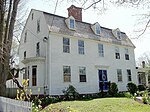Colchester, Connecticut

Colchester is a town in New London County, Connecticut, United States. The town is part of the Southeastern Connecticut Planning Region. The population was 15,555 at the 2020 census. In 2010 Colchester became the first town in Connecticut, and the 36th in the country, to be certified with the National Wildlife Federation as a Community Wildlife Habitat. The villages of Westchester and North Westchester are located within Colchester. The town center village, which was previously incorporated as a borough, is a census-designated place, with a population of 4,700 at the 2020 census.The Colchester area was part of the Mohegan territory at the time of European settlement. Several members of the Paugussett tribe currently reside in Colchester, where the tribe (which also has a heritage property in Trumbull) has a larger more recently acquired second 106-acre (0.43 km2) reservation.The Colchester Historical Society operates a local history museum in town.
Excerpt from the Wikipedia article Colchester, Connecticut (License: CC BY-SA 3.0, Authors, Images).Colchester, Connecticut
Lebanon Avenue,
Geographical coordinates (GPS) Address Nearby Places Show on map
Geographical coordinates (GPS)
| Latitude | Longitude |
|---|---|
| N 41.575944444444 ° | E -72.332305555556 ° |
Address
Lebanon Avenue 19
06415
Connecticut, United States
Open on Google Maps









